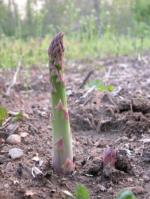Asparagus, growing
-
Asparagus is a very hardy, perennial, cool-season vegetable which can live from 12 to 15 years or longer.

Start asparagus from seed or I - to 2-year-old crowns. (The crowns are rhizomes -fleshy stems that store food for future plant growth -- with roots attached on their undersurface and the buds of nascent spears sticking up.) For best results, buy crowns from a respectable nursery. Starting plants from seed requires an extra year before harvest. Seed may be started in peat pots; they are slow to germinate, so be patient. Seedlings may be transplanted in fall. Crowns are usually set out in winter or early spring, January to February in southern California.
Choose a site with good drainage and full sun. The tall ferns of asparagus may shade other plants, so plan accordingly. Prepare the bed as early as possible and enrich it with additions of manure, compost, bone or blood meal, leaf mold, or wood ashes or a combination of several of these. In heavy soils, double-digging is recommended. To double-dig, remove the top foot of soil from the planting area. Then, with a spading fork or spade, break up the subsoil by pushing the tool into the next 10 to 12 inches of soil and rocking it back and forth. Do this every 6 inches or so.
Doubledigging is ideal for the trench method of planting asparagus. The extra work of breaking up the subsoil will be well worth the effort, especially in heavy soil. The trench is dug 12 to 18 inches wide, with 4 to 5 feet between trenches. The same method may be used in wide-bed plantings, with plants staggered in 3 rows. Mix the topsoil that has been removed with organic matter, ideally well-rotted manure, and spread about 2 inches of the mixture in the bottom of the trench or bed.
Set the plants 12 inches apart, mounding the soil slightly under each plant so that the crown is slightly above the roots. Crowns should be a grayish-brown color, plump, and healthy-looking. Remove any rotted roots before planting. Spread the roots out over the mound of soil and cover the crown with 2 to 3 inches of soil. Firm well. As the plants grow, continue to pull soil over the crowns (about 2 inches every 2 weeks) until the trench is filled. Water if rainfall is inadequate.
Asparagus takes several years to mature. Asparagus shoots (spears) should not be harvested the first season after crowns are set. After spears shoot up, let them leaf out so that the foliage can nourish the growing roots and rhizome for future production. Harvest lightly for 3 to 4 weeks the second year. The fleshy root system still needs to develop and store food reserves to support perennial growth in future seasons. Plants harvested too heavily too soon often become weak and spindly and the crowns may never recover. An extra year is added to the above schedule for asparagus started from seed; i.e., do not harvest at all the first 2 seasons, and harvest lightly the third. When the asparagus plants are in their fourth season, they may be harvested for 6 to 10 weeks per year.
Weed the bed each spring before the first shoots come up to avoid accidentally breaking off spears. During production, it is best to pull rather than hoe weeds, if possible.
When harvest is over, allow the spears to grow and leaf out. Asparagus has an attractive, fern-like foliage that makes a nice garden border. Some gardeners prefer to support the growing foliage with stakes and strings to keep them tidy. In high-wind areas, it is a good idea to plant the rows parallel to the prevailing winds so that plants can support each other.
Cut the foliage down to 2-inch stubs after freezing weather or when the foliage yellows. A 4- to 6-inch mulch of compost, manure, leaves, or other material added at this time will help control weeds and add organic matter and nutrients.

